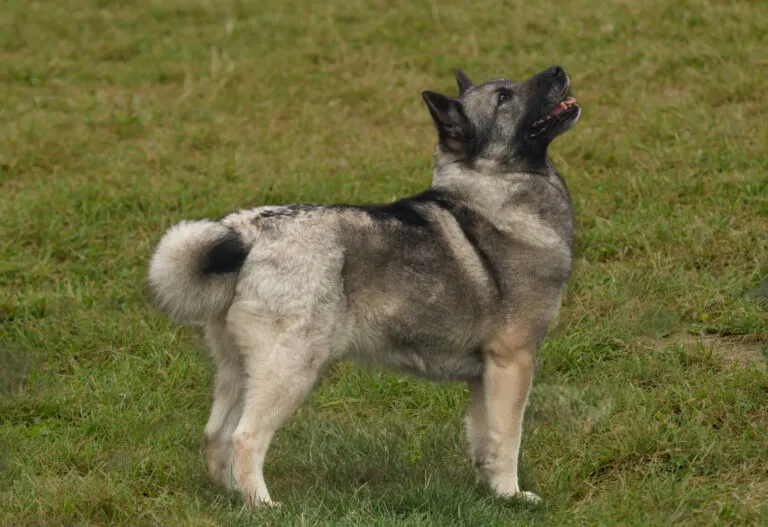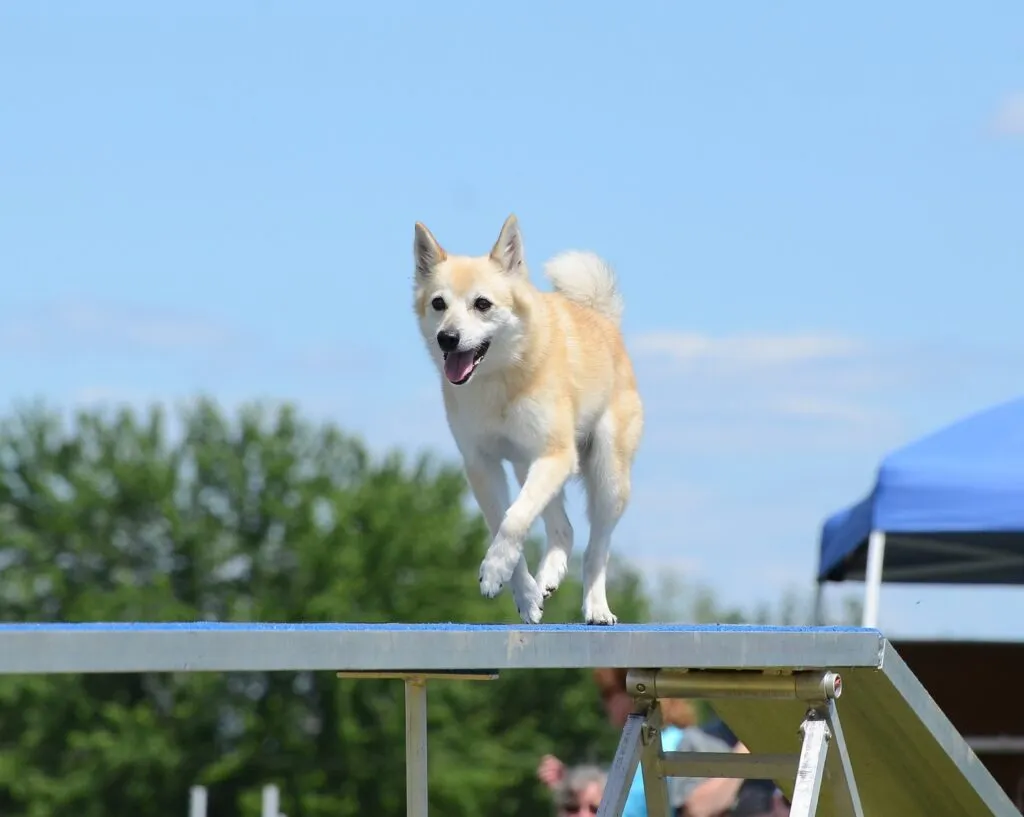Medium Size Poodle
The Norwegian Buhund is a lesser-known breed perfect for sporty dog lovers who can offer plenty of outdoor exercise.

© Sally Wallis / stock.adobe.com
The Norwegian Buhund has the classic Spitz look with erect ears, a curled tail, and a dense double coat.
The Norwegian Buhund resembles a typical Spitz with its square body, pointed erect ears, and tail curled over the back. Its keen and curious expression is a standout feature.
Females differ in the head area compared to males. Females generally weigh between 12kg to 16kg and reach a height of up to 45cm. Males, on the other hand, can weigh up to 18kg, standing up to 47cm tall.
The coat consists of a soft, dense undercoat and a rougher top coat, lying smooth against the body. The fur on the head and the front of the limbs is short, while the neck, chest area, tail, and back of the thigh feature longer fur. It comes in either wheat – also known as ‘Biscuit’ – or black.
Wheat-coloured dogs might range from light beige to yellowish red, with dark tips and masks being permissible.
The Norwegian Buhund belongs to the group of charming Nordic Spitz dogs. These have been beloved helpers and companions in Scandinavian countries for centuries. Today, many of them, including the Norwegian Buhund, are active family dogs. The name ‘buhund’ translates to ‘homestead’ and ‘livestock’ from Norwegian, highlighting its historical use as a watch and herding dog.
Archaeological findings in a Viking grave dating back to the 10th century unearthed six dog skeletons, believed to be ancestors of the Buhund. These dogs were thought to continue serving their masters in the afterlife.
Today’s Norwegian Buhunds trace back to these Viking companions, mainly bred on the rainy western coast of Norway, serving as valuable helpers and companions to herders and farmers.
It wasn’t until 1913 that the smart herders were showcased at an agricultural exhibition. Slowly but steadily, the number of Buhund enthusiasts grew, but the breed remains relatively rare and not a modern fad.
The most Buhunds outside of Norway can be found in the USA, Australia, and the UK.
 © Mark Herreid / stock.adobe.com
© Mark Herreid / stock.adobe.com
The Norwegian Buhund is deeply attached to its human family and loves being with its people. It’s known to be child-friendly and can live well with other pets if socialised from an early age.
Often, it is wary of other dogs. This breed enjoys physical and mental activities such as long outings or games. Like other Nordic herding dogs, it has a proclivity for barking, making it a good watchdog.
However, be aware that while it will alert you to strangers, the friendly and curious Buhund may greet them with a wagging tail.
The Norwegian Buhund is intelligent and cooperative, learning quickly to please its humans. Its training isn’t challenging for experienced dog owners. However, beginners should thoroughly study the breed’s needs and general dog training, especially for herding dogs, before getting one.
Consistency is crucial for successful training. From puppy age, focus on controlling barking and getting the dog used to being alone occasionally. A puppy play session and visits to a dog school can help the Buhund socialise with various dog personalities.
Always ensure that this lively dog is both physically and mentally stimulated, as boredom can lead to unwanted behaviours.
Norwegian Buhunds are generally robust and hardy. They have mostly remained free from hereditary diseases, although there is a potential risk for hip dysplasia and inherited eye conditions. To minimise risks, only purchase from breeders who conduct appropriate health tests on the parent dogs.
Responsible breeding is key. Keep your pet cool in summer by scheduling physical activities during early morning or late evening.
The thick coat makes this breed more suited to cooler climates.
An active dog like the Buhund needs a diet that provides high-quality energy. Feed your pet grain-free food with high meat content, both dry and wet foods. This means meat should be the first ingredient listed.
Adapt feeding recommendations based on your dog’s constitution and activity level. Snacks can be healthy and tasty – opt for sugar-free dental hygiene snacks or dried meat treats.
Regularly weighing your adult Buhund can help monitor its health. Fresh water should always be available.
The Buhund’s dense coat is weatherproof and easy to care for. However, it sheds quite a bit, particularly during seasonal coat changes in spring and autumn. Daily brushing during these periods can shorten the shedding phase. Outside these times, weekly brushing is sufficient.
Introduce grooming rituals early on to strengthen the bond and prepare the dog for future grooming needs. Dirt usually brushes out when dry, but in stubborn cases, a damp clean can help.
Only bathe the dog every few months to preserve its skin health, using mild dog shampoo.
Regularly check and clean its eyes and ears, especially for older dogs or those on soft surfaces, to prevent discomfort.
Explore all dog care products in the zooplus dog shop!
With agility, intelligence, and high energy, the Norwegian Buhund excels in sports. You can jog, ride, or cycle with a trained Buhund. It enjoys games of fetch and long hikes. Besides physical activity, engage its mind with agility or dog dancing.
Many Buhunds love learning tricks and are suitable for obedience training and herding. Explore different dog sports to find what you enjoy doing together.
Remember to balance activity with rest periods for a well-rounded routine.
The friendly Norwegian Buhund suits active owners who love outdoor activities regardless of weather and are dedicated to its mental stimulation. Be aware of the time commitment before choosing this active breed. Prior dog experience is advantageous.
Beginners should thoroughly research dog training and seek support from experienced dog owners, perhaps through clubs. These dogs thrive in rural areas or homes with fenced gardens. Consider the breed’s penchant for barking, which might not suit city living with sensitive neighbours.
Ensure all family members agree with getting a Buhund and are free from pet allergies. Plan for the costs involved in owning a Buhund, such as breeder prices, travel costs, initial supplies, regular expenses for dog tax, insurance, vet check-ups, and high-quality food. Plan for holiday care in advance.
Finding a Buhund often requires long journeys or international travel. Choose a breeder belonging to a club, willing to share health certifications of parent dogs. Ideally, visit the breeder to discuss the puppies and your dog-care experience.
Outside Scandinavia and mentioned countries, adult Buhunds are rare. Check club websites for Nordic dogs or contact these clubs. Similar breeds like Lapphunds or Icelandic Sheepdogs might also suit your needs.
Fans of the Bearded Collie agree that those who aren't familiar with this dog breed simply have to get acquainted with it. And those who have experienced how a Bearded Collie bolts across meadows with its flowing fur, how it rolls around full of energy and joy and how it attentively and observantly takes into account its owners wishes become simply addicted to this original dog breed and its unique charm.
The Goldendoodle isn't a breed, but a pairing between Golden Retrievers and Medium or Standard Poodles. Marketed as a low-maintenance dog for allergy sufferers, this hybrid is enjoying increasing popularity amongst dog lovers, similar to the Labradoodle.